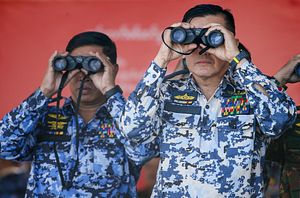In September, the Myanmar Navy quietly garnered a new milestone when it received a landing platform dock (LPD) ship, MN Moattama. Unlike the high-profile decision to acquire the Kilo-class submarine from India, the construction and delivery of MN Moattama from South Korea largely went unnoticed. Nevertheless, the induction of the medium sized, open deck LPD ship demonstrates Myanmar’s creeping entrance to a new phase of amphibious naval capability.
The Daesun Shipbuilding and Engineering of South Korea designed the MN Moattama, the hull number of which is 1501. The propulsion of the landing dock vessel is powered by combined diesel and diesel propulsion systems. The ship is equipped with a bow thruster to provide better maneuverability at critical times. Approximately 125 meters long, this semi-stealth technology equipped Makassar Class landing dock ship can facilitate 35 troops carrying tactical vehicles, and two Mi-17 medium helicopters in the flight deck at the same time. In addition to that, the tank deck as well as truck deck of the vessel can accommodate a motley range of transport assets to launch swift a marine infantry or specialized military landing operation on the shores of strategically important coastline or island.
Amphibious ships like landing platform docks (LPD) are well known for their ability to carry out multipurpose tasks. In a war situation, the LPD is used to infiltrate and exfiltrate specialized forces by sea, using light landing craft and choppers. In military missions in the vicinity of strategically vital coastlines or islands, the LPD ship provides necessary logistic support to forces stationed on coastal shores. During peacetime, the LPD is also considered a valuable asset for humanitarian assistance and disaster relief operations.
In preceding decades, the navies of Southeast Asian countries have been mulling landing platform docks as a vital military asset to embellish naval defense capabilities. Myanmar has just made an entrance into the club of amphibious naval inventory. Why was the induction of the newly built LPD MN Moattama important to Myanmar?
A vital takeaway from the event is that Myanmar has started to consider its maritime security environment more seriously. Given this level of emphasis, the induction of the amphibious transport dock ship MN Moattama is a subtle indicator of Myanmar’s new focus on its naval doctrinal strategy. Even more notably, Myanmar’s military think tanks have started to comprehend the strategic geopolitical importance of maintaining a foothold over the maritime frontiers. The MN Moattama is a step forward by the Myanmar military toward gradually adjusting its naval policy orientation to catch up with other players. The induction of the amphibious transport ship indicates Myanmar’s concentration on maritime denial capabilities.
However, it is very unlikely that, with the acquisition of a submarine and an amphibious transport ship, Myanmar’s naval capabilities would be bolstered enough to be formidable within a short time span. It will also be interesting to observe how the Myanmar Navy handles these sophisticated naval acquisitions, since the country does not have any earlier tradition of amphibious or subsurface warfare Strategic assignments and operational use of naval inventories will need to be updated from time to time for effective use in the blue water of the Bay of Bengal. Besides that, the navy needs to consider efficient maintenance capability to ensure the seaworthiness of its new amphibious transport dock ship. Any shortfall in maintenance capability would certainly affect Myanmar’s naval modernization efforts. Finally, a pivotal challenge in naval modernization is that without any coherent naval defense policy, any induction of naval assets would simply amount to futile, piecemeal efforts to balance the naval force.
At present, answers to these questions are less clear. These policy challenges will surely loom large for the Myanmar Navy in the following days.
Mohammad Rubaiyat Rahman is a Teaching Assistant at the Department of Political Science, Texas Tech University, United States.

































